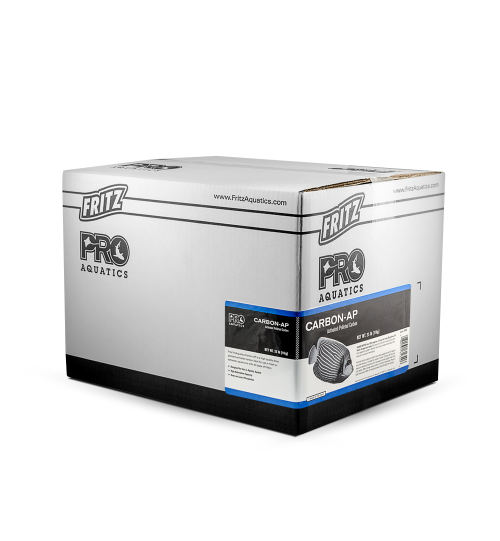About Fritz Carbon AP
Fritz Carbon AP is a high-quality, 4mm pelletized, activated carbon ideal for use in fresh or saltwater aquariums.
Directions & Dosage
Use 1/8 lb (approx. 1/2 cup) for every 20 gallons (78 liters) of aquarium water. The amount of carbon required may vary from system to system.
Monitor the clarity of water and adjust the amount of carbon if necessary. For best results, replace carbon every two weeks as part of regular tank maintenance.
To keep the carbon “active,” Carbon AP has not been pre-washed. Therefore, it is necessary to thoroughly rinse with cold water. After rinsing, place carbon in a filter media bag. Place in high flow area of filter to maximize water flow through the carbon.
Sizes
| Size | Treats | Item Number |
|---|---|---|
| 20 oz. jar | N/A | 61020 |
| 64 oz. jar | N/A | 61064 |
| 1.25 gal. bkt | N/A | 61128 |
| 25 lb. box | N/A | 61640 |
FAQs
FAQs
See below for frequently asked questions regarding Fritz Carbon AP.
-
What is adsorption?
The process whereby compounds (liquid or gas) adhere in a thin film to the surface of a solid substance. This is very different from absorption, where compounds become incorporated within the structure of another substance.
-
Why is mesh size important?
Particle size will cause the carbon to offer different flow resistance to the water being filtered through it. Fritz Industries, Inc. Super Activated Carbon is largely composed of 4×8 mesh granules.
-
What does the Carbon Tetrachloride Activity mean?
This is a test primarily used for carbons used to filter air and gases. It is included because it is an ASTM (American Society for Testing and Materials) standard. It means that the Super Activated Carbon will remove 60% of its own weight of Carbon Tetrachloride from the air at a specific temperature and concentration.
-
What does the iodine number mean?
This is the key test for a carbon used primarily for water filtration. Also an ASTM standard, the importance of this number is that it is a good indicator of how well the carbon will adsorb compounds and pollutants from the water. The testing is done by taking a known amount of powdered activated carbon and mixing it into a standard solution of iodine and water. By measuring the remainder of the iodine in solution, the amount of iodine adsorbed can be determined. This value is expressed as milligrams of iodine adsorbed per gram of activated carbon. The higher the number, the more chemical contaminants are removed. Some comparative values:
Carbon Type Iodine Number (range)
Lignate: 500-650mg/g
Bituminous: 850-1100mg/g
Coconut Shell: 1000-1500mg/gSo why use bituminous carbon over coconut shell carbon? Because coconut shell carbon almost always contains high phosphates and the smaller pore size shortens its useful life dramatically.
-
Why are hardness and moisture important?
The harder the carbon, the less likely it is to crumble during usage. Carbon that crumbles can be flushed from the system, resulting in loss of filtering capability. To determine this number, a measured amount of carbon is placed in a pan with some steel balls. The pan is then shaken for a specific period of time. The carbon is weighed after and the amount of loss measured. The % left after the shaking is the hardness number.
Moisture content reflects the liquid content of the carbon after the activation process. A low moisture level is desirable because that means you are purchasing a greater quantity of carbon as opposed to water.
-
What does the molasses number mean?
The molasses number was developed by Pittsburgh Carbon (now Calgon Carbon) to measure the sugar decolorizing capability of carbon. This number is important in the wastewater and winemaking industries where removing color is a primary objective. In the ornamental fish and aquaculture industry, there is a more limited concern with removing color and the Super Activated Carbon is highly suited to removing typical dyes (Methylene Blue, Malachite Green) and organic yellowing from water.
-
How does carbon remove chlorine and chloramines?
Rather than adsorbing the chlorine and chloramines, the carbon uses a surface area catalytic effect to reduce chlorine to chloride. This is a very rapid reaction, and because it occurs in this manner, the carbon does not become saturated with chlorine and can last a very long time for this application.
-
What is bituminous carbon?
Bituminous indicates that the activated carbon is derived from coal. It has the widest pore-size distribution and includes pores of many different dimensions, making it ideal for the removal of the widest range of organic compounds.
Other carbons in the ornamental fish/aquaculture market include the peat and lignite carbons. These carbons have a shorter life than bituminous because there is less surface area due to the larger number of macropores. Coconut shell carbon is another common carbon found in the ornamental fish/aquaculture market. This carbon has pores too small for most organic compounds and due to the softness of the carbon, may leach phenols, phosphates and acid into the water.
-
Who determines all of these standards?
The American Society for Testing and Materials (ASTM) is a not-for-profit organization that exists for the development and publication of standards for material, products, systems and services. Carbon standards are formulated by the Committee on Activated Carbon, composed of manufacturers, distributors, original equipment manufacturers (OEMs), quality control equipment manufacturers, end users and academia.
Submit a Question
Can't find what you're looking for? Ask us a new question.
